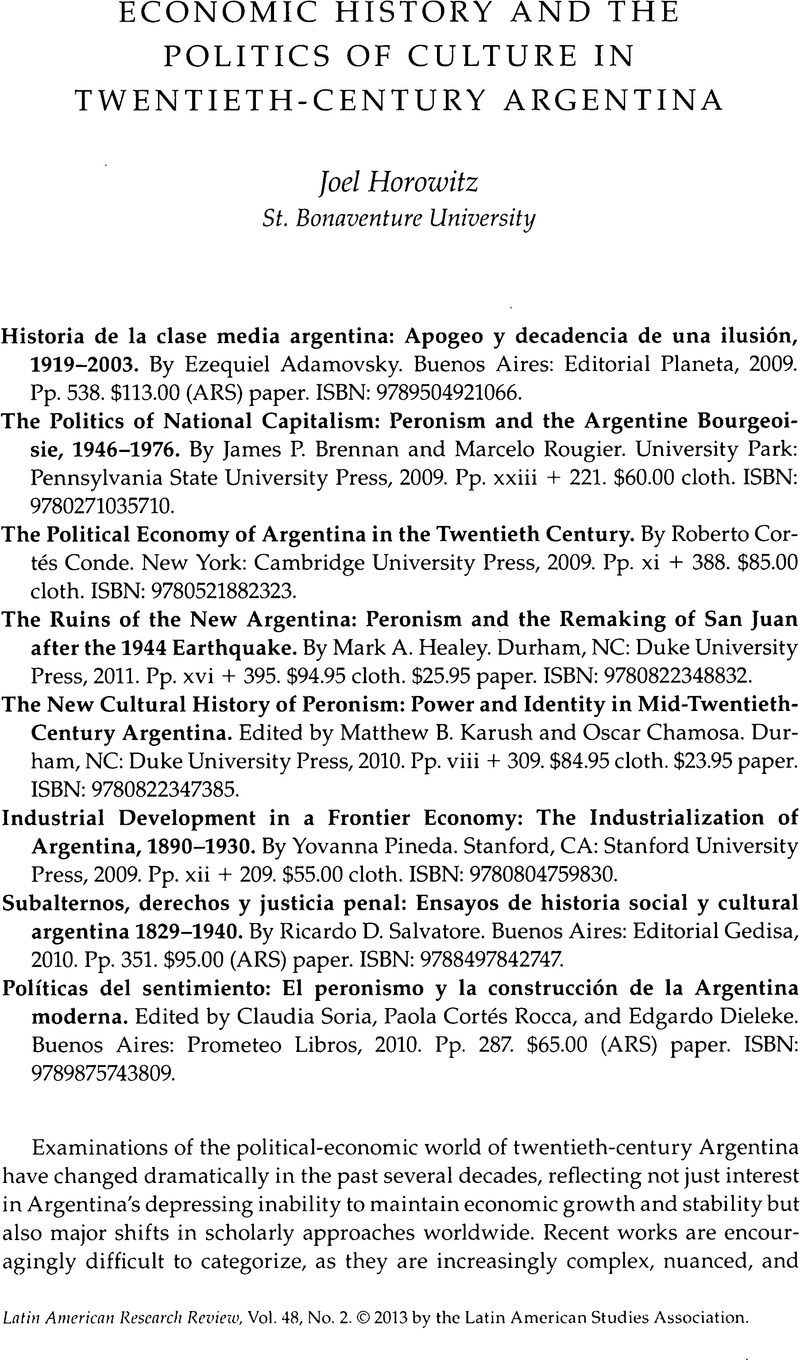No CrossRef data available.
Article contents
Economic History and the Politics of Culture in Twentieth-Century Argentina
Review products
Published online by Cambridge University Press: 05 September 2022
Abstract

- Type
- Review Essays
- Information
- Copyright
- Copyright © 2013 by the Latin American Studies Association
References
1. For a pioneering work in this vein, see Carlos Díaz Alejandro, Essays on the Economic History of the Argentine Republic (New Haven, CT: Yale University Press, 1970).
2. Guido Di Tella and Manuel Zymelman, Las etapas del desarrollo económico argentino (Buenos Aires: Editorial Universitaria de Buenos Aires, 1967).
3. Fernando Rocchi, Chimneys in the Desert: Industrialization in Argentina during the Export Boom Years, 1870–1930 (Stanford, CA: Stanford University Press, 2005).
4. See Joel Horowitz, Argentine Unions, the State and the Rise of Perón, 1930–1945 (Berkeley: Institute for International Studies, University of California, 1990), esp. 53.
5. “Cada generación ha entendido de manera distinta el peronismo; este libro es el mapa de la visión del peronismo de la nueva generación.” Reviewer's translation.
6. Juan Carlos Torre, La vieja guardia sindical y Perón: Sobre los orígenes del peronismo (Buenos Aires: Sudamericana, 1990), 11–18; Miguel Murmis and Juan Carlos Portantiero, Estudios sobre los orígenes del peronismo (Buenos Aires: Siglo Veintiuno, 1971).
7. Daniel James, Resistance and Integration: Peronism and the Argentine Working Class, 1946–1976 (Cambridge: Cambridge University Press, 1988); Mariano Ben Plotkin, Mañana es San Perón: Propaganda, rituales políticos y educación en el régimen peronista (1946–1955) (Buenos Aires: Ariel, 1993).
8. For example, see comments by Anahí Ballent, Políticas del sentimiento, esp. 222.
9. A large kitschy outline of Evita now looms from the side of a government building overlooking the widest street in Buenos Aires.
10. See Oscar Chamosa, The Argentine Folklore Movement: Sugar Elites, Criollo Workers and the Politics of Cultural Nationalism, 1900–1955 (Tucson: University of Arizona Press, 2010); Eduardo Elena, Dignifying Argentina: Peronism, Citizenship, and Mass Consumption (Pittsburgh, PA: University of Pittsburgh Press, 2011); Matthew B. Karush, Culture of Class: Radio and Cinema in the Making of a Divided Argentina, 1920–1946 (Durham, NC: Duke University Press, 2012).
11. See, for example, Federación, September 1933, p. 3.
12. Sebastián Marotta, El movimiento sindical argentino (Buenos Aires: Editorial Calomino, 1970), 3: 60; Horowitz, Argentine Unions.
13. The example he highlights is the case of Simón Radowitsky, the famous anarchist, which Salvatore wrongly describes. He has Radowitsky dying in prison in Ushuaia (275–276). Radowitsky was pardoned by Hipólito Yrigoyen and died decades later in Mexico.




